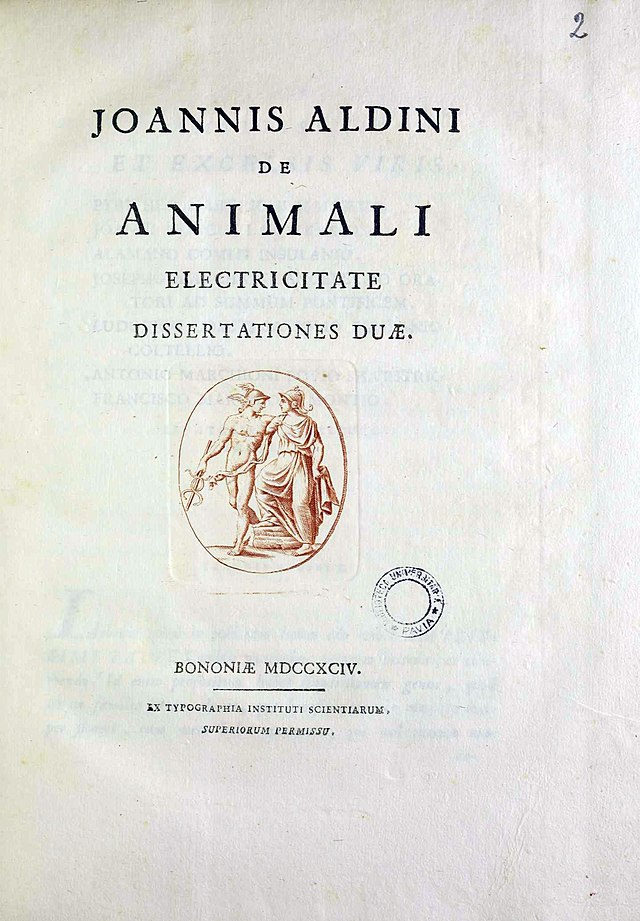Top Qs
Timeline
Chat
Perspective
Giovanni Aldini
Italian physician and physicist (1762–1834) From Wikipedia, the free encyclopedia
Remove ads
Giovanni Aldini (10 April 1762 – 17 January 1834)[1] was an Italian physician[2] and physicist born in Bologna. He is considered a pioneer in the field of electrophysiology.[3]
Remove ads
Biography
Summarize
Perspective
Giovanni Aldini was born in Bologna on 10 April 1762. He was a brother of the statesman Count Antonio Aldini, secretary of state for the Kingdom of Italy between 1805 and 1814. He graduated in physics at University of Bologna in 1782.[4] In 1798, he became professor of experimental physics at University of Bologna, in succession to his uncle Luigi Galvani (1737–1798).[5]
Aldini's scientific work was chiefly concerned with galvanism, anatomy and its medical applications, with the construction and illumination of lighthouses, and with experiments for preserving human life and material objects from destruction by fire. He wrote in French and English in addition to his native Italian, and in Latin, still used in the 18th century by the scientific community.
Aldini was one of the earliest and most active members of the National Institute of Italy, to the foundation of which he contributed. In recognition of his merits, the emperor of Austria made him a Knight of the Iron Crown and a councillor of state at Milan. Aldini spent the last years of his life in Milan, where he died on 17 January 1834, at the age of 71. He bequeathed a considerable sum to found a school of natural science for artisans at Bologna.[1]
Remove ads
Experiments

Aldini's most famous public demonstration of the electro-stimulation technique of deceased limbs was performed on the executed criminal George Forster at Newgate in London in 1803.[6][7] The Newgate Calendar describes what happened when the galvanic process was used on the body:
On the first application of the process to the face, the jaws of the deceased criminal began to quiver, and the adjoining muscles were horribly contorted, and one eye was actually opened. In the subsequent part of the process, the right hand was raised and clenched, and the legs and thighs were set in motion.[8]
Aldini's experiment created a sensation since it seemed to demonstrate that electricity could be used to revive the deceased.
Remove ads
Shelley's Frankenstein association
Although Mary Shelley was just 5 years old when Foster was executed, it has been suggested that Aldini might have been the inspiration for her famous fictional character Victor Frankenstein.[9] Shelley was well read in the sciences and her husband Percy Bysshe Shelley was an amateur chemist.[9] In her introduction to the 1831 edition of Frankenstein, she does not mention Aldini, but "galvanism" was among the evening discussion topics before she experienced her "waking dream" that led to her writing.[10] Chapter 5, the creature awakened:
By the glimmer of the half-extinguished light, I saw the dull yellow eye of the creature open; it breathed hard, and a convulsive motion agitated its limbs.
Selected works

- De viribus electricitatis in motu musculari commentarius cum I. A. dissertatione et notis, Modena, 1792.
- De animali electricitate. Bologna: Stamperia dell'Instituto delle Scienze. 1794.
- Précis des expériences galvaniques, Paris, 1803; an account of some experiments made by Aldini, principally upon the bodies of dead animals. This work was translated from the French manuscript into English, and published under the title An Account of the late improvements in Galvanism, by John Aldini, London, 1803, with an appendix, containing experiments upon the bodies of executed criminals, performed by Aldini in Newgate and Bologna.
- Essai théorique et expérimental sur le galvanisme, avec une série d’expériences faites devant des commissaires de l’Institut national de France, et en divers amphithéâtres anatomiques de Londres [Theoretical and Experimental Essay on Galvanism: With a Series of Experiments Made in the Presence of the Commissioners of the National Institute of France, and in Various Anatomical Amphitheaters in London]. Paris: Fournier Fils. 1804.
- General Views on the Application of Galvanism to Medical Purposes; Principally in Cases of Suspended Animation, London, 1819. The treatise explores the potential of electricity to revive individuals in a state of suspended animation.
Remove ads
References
Further reading
External links
Wikiwand - on
Seamless Wikipedia browsing. On steroids.
Remove ads

